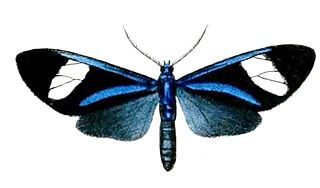Related Research Articles

Urodidae, whose species are commonly known as false burnet moths, is a family of moths in the lepidopteran order. It is the type genus in the superfamily, Urodoidea, with three genera, one of which, Wockia, occurs in Europe.
Agathiphaga is a genus of moths, known as kauri moths. and is the only living genus in the family Agathiphagidae. This caddisfly-like lineage of primitive moths was first reported by Lionel Jack Dumbleton in 1952, as a new genus of Micropterigidae.

Euagra is a genus of moths in the subfamily Arctiinae. The genus was erected by Francis Walker in 1854.

The Thyatirinae, or false owlet moths, are a subfamily of the moth family Drepanidae with about 200 species described. Until recently, most classifications treated this group as a separate family called Thyatiridae.
Victor Gurney Logan Van Someren was a zoologist and entomologist. Van Someren was born in Australia. He attended George Watson's College and studied zoology at University of Edinburgh. He was also a dentist. Van Someren moved to Kenya in 1912 and lived in Nairobi. He was in the East Africa and Uganda Natural History Society and became Honorary Secretary. In 1930 he became Curator of the Coryndon Museum. Van Someren named a number of bird and butterfly species.
Euagra azurea is a moth of the subfamily Arctiinae. It was described by Francis Walker in 1854. It is found in Brazil.
Euagra caerulea is a moth of the subfamily Arctiinae. It was described by Paul Dognin in 1891. It is found in Ecuador.
Euagra cerymica is a moth of the subfamily Arctiinae. It was described by Herbert Druce in 1893. It is found in Panama.
Euagra coelestina is a moth of the subfamily Arctiinae. It was described by Caspar Stoll in 1781. It is found in Suriname and the Brazilian state of Pará.
Euagra fenestra is a moth of the subfamily Arctiinae. It was described by Francis Walker in 1854. It is found in Brazil.
Euagra haemanthus is a moth of the subfamily Arctiinae. It was described by Francis Walker in 1854. It is found in Mexico, Guatemala and Panama.
Euagra intercisa is a moth of the subfamily Arctiinae. It was described by Arthur Gardiner Butler in 1876. It is found in Venezuela.
Euagra klagesi is a moth of the subfamily Arctiinae. It was described by Rothschild in 1912. It is found in Suriname.

Euagra latera is a moth of the subfamily Arctiinae. It was described by Herbert Druce in 1890. It is found in Ecuador and São Paulo, Brazil.
Euagra monoscopa is a moth of the subfamily Arctiinae. It was described by William James Kaye in 1919. It is found in Ecuador.
Euagra perpasta is a moth of the subfamily Arctiinae. It was described by Max Wilhelm Karl Draudt in 1917. It is found in Colombia.
Euagra seraphica is a moth of the subfamily Arctiinae. It was described by Max Wilhelm Karl Draudt in 1917. It is found in Colombia.
Euagra splendida is a moth of the subfamily Arctiinae. It was described by Arthur Gardiner Butler in 1876. It is found in Brazil.
References
- ↑ Beccaloni, G.; Scoble, M.; Kitching, I.; Simonsen, T.; Robinson, G.; Pitkin, B.; Hine, A.; Lyal, C., eds. (2003). "Euagra delectans". The Global Lepidoptera Names Index . Natural History Museum . Retrieved May 3, 2018.